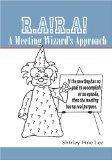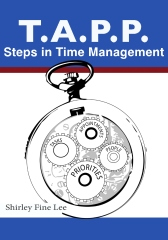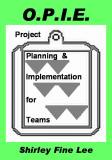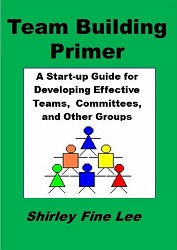|
|
|
Testimonials
Shirley was critical to the success experienced by the
functional team. Her experience and skills in project management helped the
team to get and stay on track. She helped us with problem solving, defining
our requirements and development of test cases. Because of her system
background, she knew exactly what had to be accomplished and the
order/timeframe that it should be accomplished in. She was extremely
instrumental in helping me understand the scope of the project. She was
always accessible so that I could ask questions, explore issues and get
assistance. - System Deployment Project Leader
Shirley is an excellent facilitator and an expert on
teaming. She keeps us on track in Quality Improvement team meetings, often
suggesting different problem solving techniques. - Programmer
Shirley's energy and enthusiasm are excellent examples
for the rest of us. I have seen many occasions when Shirley was able to get
a group moving just because of the enthusiasm she showed on the topic at
hand. That is very contagious. - Leadership Training Manager
Click here for more |

Click
cover above to order Paperback Book or below for
RARA A
Meeting Wizard's Approach Kindle e-Book

Click
cover above to order Paperback Book or below for
TAPP Steps
in Time Mgmt Kindle e-book

OPIE
Project Planning and Implementation for Team - Only available as Kindle e-book
on Amazon |
Management
/ HR Statistics
NOTE: These statistics
have been gathered from various sources, therefore original source of
data or date published may not be available.
Communication
- We retain 10% of what we read. We retain 20% of
what we hear. We retain 30% of what we see. We retain 50% of what we
hear and see. We retain 70% of what we say. We retain 90% of what we
do.
- 95% of divorces are caused by a "lack of
communication"
- The average working person spends less than 2
minutes per day in meaningful communication with their spouse or
"significant other" and less than 30 seconds a day in meaningful
communication with their children.
- One in eight telephone calls get repeated
because something was forgotten.
Meetings
-
According to an article in the Fall
2006 issue of The Facilitator newsletter, using a skilled
facilitator increase the productivity of a project by 25%.
-
49% of participants
considered unfocused meetings & projects as the biggest
workplace time waster and the primary reason for unproductive
workdays.
-
It takes less than eight
seconds for an idea, suggestion, or proposal to be criticized.
-
According to the article "Meeting
Rooms of the Future" in Group Computing Magazine, Sept/Oct 1998, then
number of team meetings involving remote participation have increased
from 5% to 25% over 10 years.
-
When someone is asking for our time
for a meeting, 80% of the time, there is an alternate date and time
that will be acceptable.
-
Koontz said "Most managers spend up to
10 hours a week in meetings, and 90% say more than half that time is
wasted."
-
On an average day, there are 17
million meetings in America.
-
Research conducted by the Annenberg School of
Communications at UCLA and the University of Minnesota’s Training &
Development Research Center show that executives on average spend
40-50% of their working hours in meetings. The studies also point out
that as much as 50% of meeting time is unproductive and that up to 25%
is spent discussing irrelevant issues.
9 out of 10 people daydream in
meetings.
-
60% of meeting attendees take notes to
appear as if they are listening.
-
63% of the time, typical meetings in
America do not have prepared agendas.
-
Communispond, Inc., a New York
consulting firm, conducted a poll of 471 management leaders and found
that well over one-half of the respondents to their survey considered
many meetings to be a "waste of time." Some 90 percent attributed the
failure of most meetings to a "lack of advanced planning and
organization," and over three-fourths of those surveyed indicated that
they received no formal training on how to conduct a meeting.
-
According to a University of Arizona
teamwork
study, there
are more than 11 million formal meetings per day in the United States
- more than three billion meetings per year. Managers spend about 20%
of their time in formal meetings of 5 people or more. A meeting
between several managers or executives may cost upwards of $1000 per
hour in salary costs alone. A Fortune 50 company estimates losses in
excess of $75 million per year due to poor meetings.
-
In a 2001 Tulsa University paper,
studies showed that meetings are essential and that the number of
meetings and their duration has been steadily increasing. Studies of
managers and knowledge workers reveal that they spend between 25%-80%
of their time in meetings, suggesting that meetings are an important
part of one's working life. Estimates of meeting expenses range from
costs of $30 million to over 100 million per year to losses between
$54 million and 3.7 billion annually! Self estimates of meeting
productivity by managers in many different functional areas range from
33%-47%.
-
A Microsoft Office survey including respondents
worldwide showed say they feel unproductive for as much as a third of
their workweek. Internationally the top three time
wasters, according to survey participants, were ineffective meetings,
unclear objectives and lack of team communication. In the U.S.A,
42% cited procrastination, 39% picked lack of team communication and
35% chose ineffective meetings among the top time wasters.
-
A nationwide survey developed by Office Team, a
staffing service specializing in skilled administrative professionals
finds that "runaway" meetings are the biggest time waster in the
workplace. More than 27 percent of workers polled said meetings are
the largest reason for inefficiency and lack of productivity.
-
Industry Week called meetings "the Great White Collar
Crime" estimating they waste 37 billion dollars a year.
-
A Wall Street Journal article
suggested that following a detailed agenda and starting on time would
reduce the time managers spend in meetings by 80 percent.
-
According to a survey by MCI Conferencing, most
professionals who meet on a regular basis admit that they do the
following: daydream 91%, miss meetings 96%, miss parts of
meetings 95%, bring other work to meetings 73%.
-
According to the National Statistics Council, an
average of 37% of employee time is spent in meetings. During an
average meeting, agenda items are covered in only 53% of the scheduled
time, with the remaining time as unproductive.
-
Executives average 23 hours per
week in meetings where 7.8 hours of the 23 are unnecessary and poorly
run, which is 2.3 months per year wasted.
Problems
-
80% of "Crisis Management" events are
preventable.
-
It takes less than eight
seconds for an idea, suggestion, or proposal to be criticized.
-
The Innovator Newsletter reported a
benchmarking study that concluded innovation & creativity, teamwork,
customer service, problem solving, adaptive skills, shared leadership,
and communication were the top ten competencies necessary for success
over the next five years.
-
The average person makes over 5,000
decisions in a typical day.
Projects
-
Study indicated if a project is 15%
complete and problems occur, project will stay in trouble through
completion.
-
It almost always takes twice as long
to complete a task as what we originally thought it would take.
-
70% of projects fail to deliver the benefits anticipated
at the outset.
-
A 1998 Information Technology project
survey of 203 participants indicated the following reasons for failure:
75% deadlines missed, 55% budget exceeded, 40% poor communications,
37% unmet project requirements. The same survey indicated the
following as project success factors: 51% meet milestones, 32%
maintain quality levels, 31% meet budget.
-
The "20/80 Rule" tells us we will
typically accomplish 80% of our results through 20% of our effort. The
other 20% of additional results comes from about 80% of additional
effort.
-
No one is truly available to a project
100%. Most can get up to 80% availability from people tied to their
workstations, such as factory workers. For knowledge workers highest
availability would be 50% - 60%.
-
A project tends to expand with the
time allocated for it." If you give yourself one thing to do, it will
take all day. If you give yourself two things to do, you get them both
done. If you give yourself a dozen things to do, you may not get 12
done, but you’ll get 7 or 8 completed.
-
Over 90% of project failures are due
to poor planning.
-
In most of the cases, poor software
implementation is due to bad or poorly articulated requirements.
According to the Standish Group, a research firm, 31% of software
projects are cancelled before ever reaching the customers while 53%
cost 189% or more of their original budgets. Many experts believe that
40-60 percent of software defects and failures are attributed to bad
requirements.
-
Post-implementation reviews of most
information systems projects typically show that 60-75% of all defects
encountered during a project, and embedded in the finished systems
products, are defects in requirements.
Teams
Research by the Center for Creative Leadership
has found that the primary causes of derailment in executives involve
deficits in emotional competence. The three primary ones are
difficulty in handling change, not being able to work well in a team,
and poor interpersonal relations. After supervisors in a manufacturing
plant received training in emotional competencies such as how to
listen better and help employees resolve problems on their own,
lost-time accidents were reduced by 50 percent, formal grievances were
reduced from an average of 15 per year to 3 per year, and the plant
exceeded productivity goals by $250,000 (Pesuric & Byham, 1996).
Fortune 500 companies that use Six Thinking
Hats report that their teams are more productive and now invest 50%
less time in meetings. They refer to their teams as healthier and
happier.
A study, performed by the Human Resources
Planning Society, of 100 Fortune 500 companies with teams, found that
80% of their respondents had trouble evaluating the team's work (Eisman,
1995).
Research by Shaw and Schneier (1995) showed
companies struggle with how to measure and reward team performance,
two essential components of team success, and that few companies are
actually satisfied with their methods.
In a study surveying 88 companies with teams,
researchers found that most companies lacked effective rewards,
individual and team performance feedback mechanisms, project management
skills, and individual and team goal-setting skills (Tippett & Peters,
1995).
Lawler, Mohrman, and Ledford (1995) reported
use of self-managed work teams and problem-solving groups three times
over a 6-year interval (i.e., 1987, 1990, and 1993).Their findings
indicate both types of teams in the Fortune 1000 rose steadily during
the period in question. The use of problem-solving groups increased
from 74% in 1987 to 84% in 1990, and 91% in 1993. The use of
self-managed work teams rose from 27% in 1987, to 47% in 1990, and
then to 68% in 1993.
Time
- 1 hour of planning will save 10 hours of doing.
- 10-12 minutes invested in planning your day
will save at least 2 hours of wasted time and effort throughout the
day - from "Eat the Frog" by Brian Tracy.
- The average person gets 1 interruption every 8
minutes, or approximately 7 an hour, or 50-60 per day. The average
interruption takes 5 minutes, totaling about 50% of the average
workday. 80% of those interruptions are typically rated as "little
value" or "no value" creating approximately 3 hours of wasted time per
day.
- A manager on average spends 3 hours each day on
interruptions.
- Reducing staff members wasted time by just five
minutes every hour would increase productivity 8.3%.
- When an interruption occurs, it takes 10 to 15
minutes to get back on track with train of thought afterwards.
Therefore 4 interruptions in a day can mean the loss of an hour in
concentration.
- 20% of the average workday is spent on
"crucial" and "important" things, while 80% of the average workday is
spent on things that have "little value" or "no value".
- The "20/80 Rule" tells us we will typically
accomplish 80% of our results through 20% of our effort. The other 20%
of additional results comes from about 80% of additional effort.
- Taking 5 minutes per day, 5 days per week to
improve one’s job will create 1,200 little improvements to a job over
a 5 year period.
- The average person uses 13 different methods to
control and manage their time.
- 70% of business and professional people use a
"to do" list on a regular basis to administer their "have to’s".
- The average time allotted to respond to data
gathering requests are: to meet or talk is 1 hour, for response to
memo or email is 10 minutes, for preparing a report or memo an evening
or weekend is typically given up. This willingness to respond does not
necessarily add value, although it most likely will increase the
number of requests the responder will get in the future..
- 5% of business and professional people use a
"to do" list on a regular basis to administer not only their "have
to’s", but also their "want to’s".
- The average worker spends 35 minutes per day
commuting.
- 40% of working people skip breakfast. 39% skip
lunch. Of those who take a lunch break, 50% allow only 15 minutes of
less.
- Boston Market Survey on lunch times says 37% of
Americans take less than 15 mins. However 79% said they were more
productive after a food lunch and 60% said they were more positive
about work after a good lunch.
- A productivity consultant said "On any given
day, an executive can expect to be interrupted 150 to 300 times a day,
not counting e-mails"
- In the last 20 years, working time has
increased by 15% and leisure time has decreased by 33%.
- It almost always takes twice as long to
complete a task as what we originally thought it would take.
- More
Time Management Facts and Figures
Workspace
- Studies show we lose an average of 1 -2 hours
per day searching for missing items in messy files, closets and
stacks.
- Americans spend 50 - 70 % of work hours on
paperwork.
- Buying duplicate or last minute supplies due to
disorganization can cost a business up to 20% of annual purchasing
budget.
- The average worker sends and receives 190
messages per day
- Americans waste 9 million hours per day
searching for lost or misplaced items.
- Wall Street Journal reported that the average
executive loses 6 weeks per year searching for missing information in
messy desks and files (almost 1 hour per day per person).
- Filing cabinets and drawers should have at
least 39 inches of clearance space in front of them in order to open
completely.
- The average office takes 3 days to organize.
- Cleaning professionals state that getting rid
of clutter could cut cleaning time as much as 40%.
- The minimum suggested size for a desk is 59
inches wide by 33 inches deep.
- 75-85 % of filed documents are never looked at
again.
- A person who works with a "messy" or cluttered
desk spends, on average, 1 1/2 hours per day looking for things or
being distracted by things or approximately 7 1/2 per workweek.
- Per Julie Morgenstern in "Organizing from the
Inside Out", it takes approximately 24 hours to organize the average
job office, up to 30 hours to organize a home office, 22 hours for a
work cubicle, and potentially 7 hours for a mobile office. Once the
office is organized, maintenance of these offices should take only
10-15 minutes per day.
- A managers desk holds 36 hours work. The
average manager spends 3 hours each week looking for things on that
desk
- 43% of people find it difficult to delegate.
General
|
|
|
|
|
|
| |

Click
cover above to order Paperback Book or below for
RARA A Meeting Wizard's Approach Kindle e-Book

Click
cover above to order Paperback Book or below for
TAPP Steps in Time Mgmt Kindle e-book

OPIE Project Planning and Implementation for Team - Only available as Kindle
e-book on Amazon

Team Building Primer: A Start-up Guide for Developing Effective Teams,
Committees, and Other Groups
|